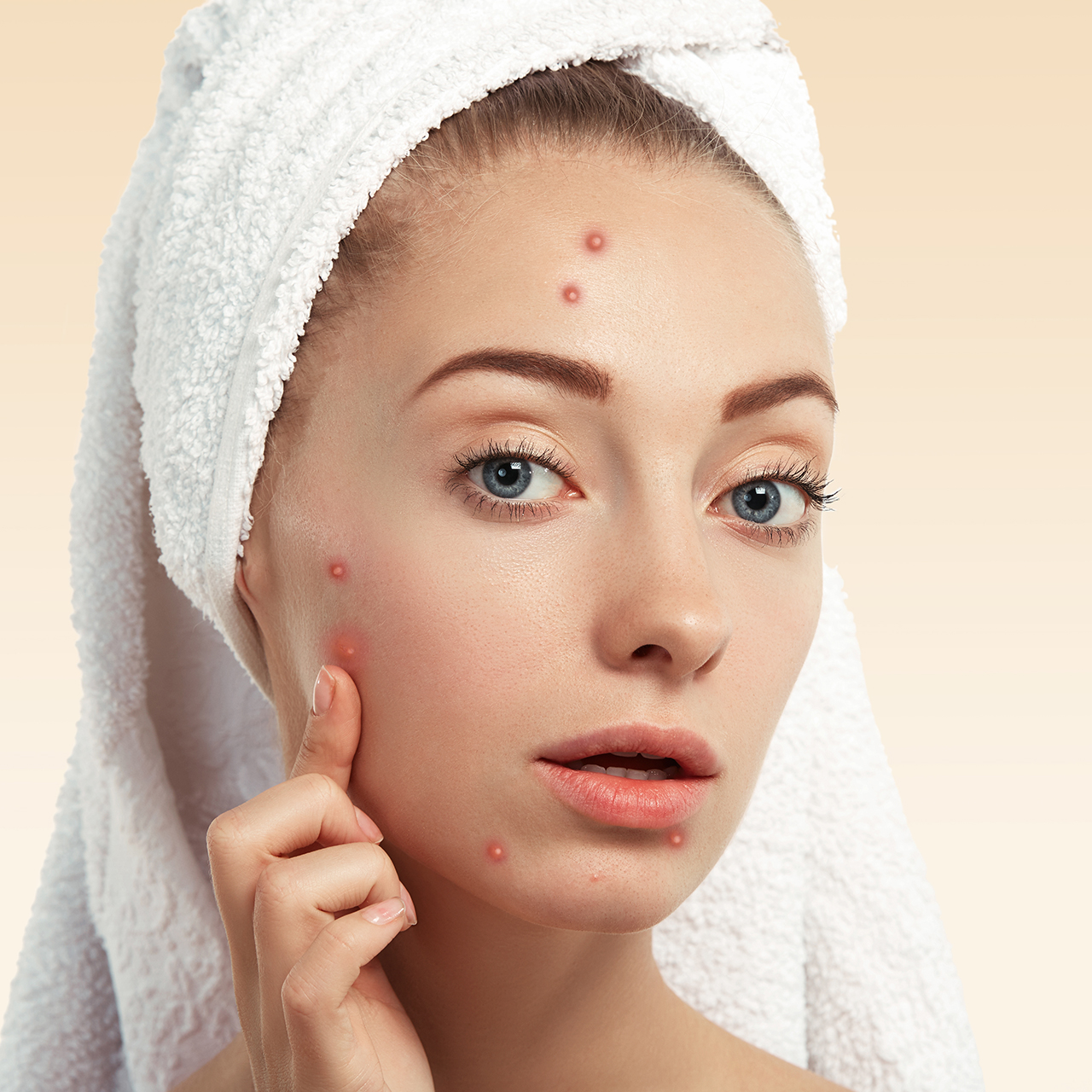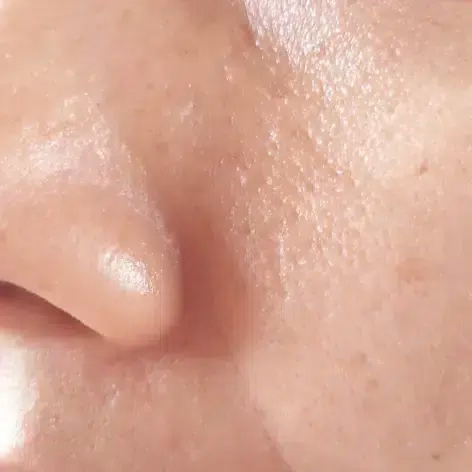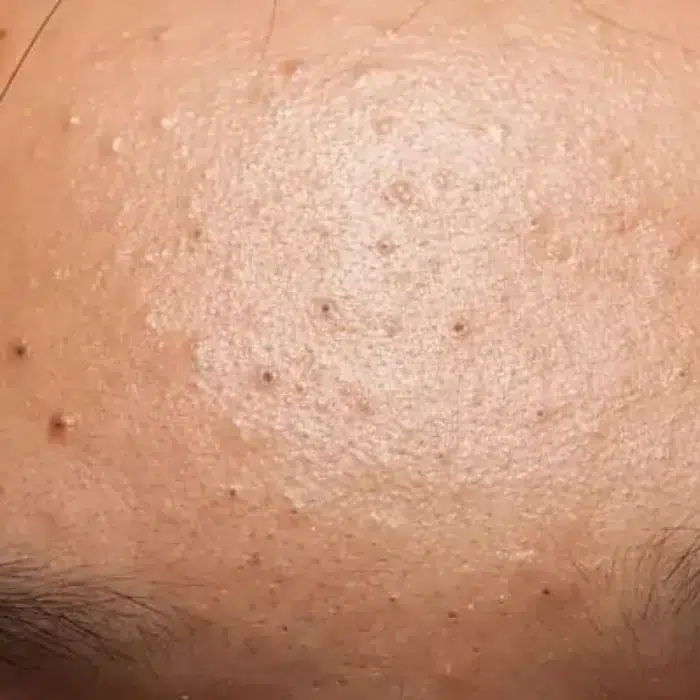Facial Care
Discover Our Aesthetic Treatments for the Face

Acne is a very common skin condition in France, affecting approximately 6 million people, mostly adolescents (60%, of which 15% have severe acne) but also 25% of adults, especially women.
Acne is not an infectious disease but an inflammatory disease of the pilosebaceous follicle.
At the base of each hair, there is a sebaceous gland that secretes sebum, an oily fluid that flows through the pores, whose normal function is to protect the skin.
In acne, the skin pores are clogged with either excessively viscous (thick) sebum or excessive sebum production, along with poorly evacuated dead skin cells (keratinocytes). The malfunctioning of this pilosebaceous follicle is associated with the proliferation of a bacterium, Propionibacterium acnes (naturally present on the skin), which secretes pro-inflammatory substances.
CAUSES OR AGGRAVATING FACTORS OF ACNE
Acne can have various causes (genetics, stress, hormonal abnormalities, diet, sun exposure, lifestyle, inappropriate skincare, etc.), some of which are recognized:
- Use of substances that can aggravate acne lesions or clog pores: oils, tar, chlorine, unsuitable cosmetics, essential oils, etc.
- Intake of certain medications:
- Androgens in women and men for sports-related doping.
- Oral contraceptives containing androgenic progestins.
- Topical and systemic corticosteroids.
- Certain anti-epileptic medications that increase sebum secretion.
- Lithium salts and certain antidepressants.
- Acne revealing an endocrinopathy: acne accompanied by signs of hyperandrogenism such as hirsutism, alopecia, menstrual disorders, or infertility, requires hormonal blood tests and abdominal-pelvic ultrasound to search for polycystic ovary syndrome.
TREATMENT OPTIONS FOR ACNE AT CLINIQUE BIOLASER SAINT-LOUIS/BASEL
- During the essential first consultation, a personalized treatment plan will be proposed to you, along with a written estimate and a consent form for each technique used. The doctor will ensure that you have no contraindications.
- A single technique with a specific number of sessions or a combination of several techniques may be proposed depending on the type and severity of your acne.
- Nordlys IPL:
The Nordlys IPL treatment reduces blood supply to the sebaceous gland, leading to a slowdown in sebum production. The light emitted by Nordlys IPL also has the ability to directly destroy some of the bacteria present on the skin's surface. Best results are achieved with inflammatory acne: red, painful, and raised pimples. It is essential that the skin is not tanned and has not been recently exposed to the sun. Ellipse IPLTM technology improves the appearance of acne pimples, pigmentation irregularities, and skin tone.
- Peeling:
The Purify range developed by Laboratoire Eneomey specifically caters to acne-prone skin. Through a unique combination of dermatological actives, the Purify program effectively eliminates dead cells and reduces sebum secretion for purified and healthy skin. This program exfoliates and unclogs pores efficiently, resulting in refined skin texture and purified skin.
- LED:
MEDISOL® LED treatment improves resistant acne, rosacea, and reduces acne scars. Blue LEDs target the porphyrins of Propionibacterium acnes bacteria, destroying them. Red LEDs penetrate deep enough to reach sebaceous glands and exert an anti-inflammatory action. It is recommended to alternate red and blue light sessions within the same week.
- Topical, systemic, and cosmetic treatments.
WHO CAN BENEFIT FROM THESE ANTI-ACNE TREATMENTS?
- All acne patients who have already received oral treatments with antibiotics or Isotretinoin (Roaccutane), experienced failures or recurrent outbreaks, and no longer wish to pursue conventional treatments. Oral Isotretinoin must have been stopped for at least 6 months.
- Patients who do not want or cannot take oral medications.
- Adolescents who are too young for Isotretinoin to prevent significant skin damage leading to indelible scars.
SHOULD A MAINTENANCE TREATMENT BE DONE?
A maintenance treatment every 4 to 6 months will help maintain the results longer. Acne is influenced by hormonal fluctuations, stress (cortisol production), and medication intake (cortisone, antidepressants). It is essential to understand that these factors can lead to recurrences without the treatment's effectiveness being blamed.
WHAT PRECAUTIONS SHOULD I TAKE BEFORE AND AFTER THE NORDLYS IPL TREATMENT?
The used pulsed light is entirely safe, and generally, no special care is required after the treatment. However, people with sensitive skin can benefit from applying a cold compress to the face immediately after the treatment or using a cream prescribed by the doctor.
You may notice general redness on the face after the treatment. If your skin is sun-damaged, some pigmented spots may become darker and eventually fade away.
Since acne is challenging to completely eradicate, your doctor may recommend continuing topical treatments for a few months after the end of the Nordlys treatment sessions or combining with other treatments. In case of a possible acne flare-up, the treatment can be repeated.
The acne treatment with Nordlys IPL is a combined therapy. Therefore, your doctor may propose complementary treatments (LED, peeling, cosmetology, etc.) to optimize the acne treatment.
HOW LONG DOES A NORDLYS IPL TREATMENT LAST?
Approximately 60 flashes are required to treat the entire face. Including the consultation and post-treatment preparation, it takes about 20 minutes. A typical treatment comprises four sessions, spaced one month apart. The number of sessions needed will depend on the severity of the condition and the area to be treated.
MAIN TYPES OF ACNE LESIONS:
HYPERSEBORRHEA
Hyperseborrhea is constant. It is the first manifestation of acne that can precede the appearance of acne pimples by several years.
The skin is oily, shiny, and the pores are dilated.
It affects areas rich in sebaceous glands: the central part of the face (nose, forehead, chin, cheeks) and the upper thoracic region (neck, back, and anterior chest area).


RETENTIONAL LESIONS
There are two types of retentional lesions: closed comedones and open comedones:
Closed comedones (or microcysts) are small whitish papules, 2-3 mm in size, sometimes more palpable than visible. They are caused by the accumulation of sebum and keratin mixed in the dilated follicular canal, which leads to a hardened and localized swelling of the skin centered around a pale area, hence the name "whitehead."
Open comedones correspond to "blackheads" and measure between 1 and 3 mm in diameter. The black color corresponds to the accumulation of oxidized keratinocytes within the dilated orifice of the infundibular canal, which can be spontaneously expelled or become inflamed.
INFLAMMATORY LESIONS
The inflammatory phase begins when there is a sufficient number of bacteria in the sebaceous gland. They multiply and secrete pro-inflammatory factors, resulting in inflammatory lesions such as papules, pustules, nodules, and abscesses.
Superficial inflammatory lesions include raised red inflamed bumps without pus, measuring 1 to 5 mm in diameter, sometimes tender (papules), and red bumps with white heads and whitish-yellowish purulent collection (pustules).






